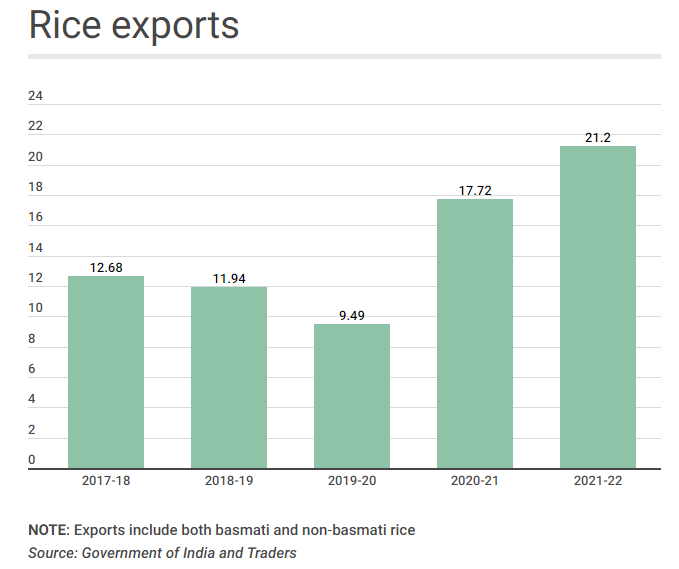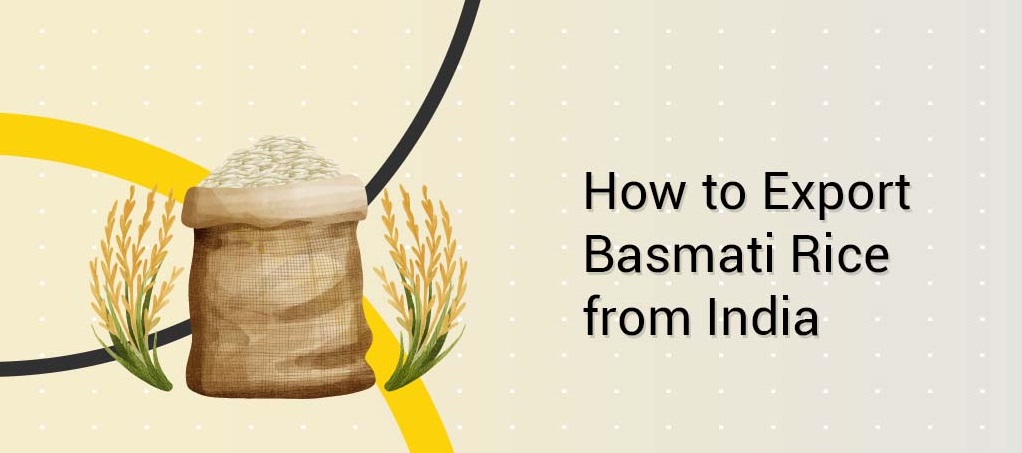In this blog, we will learn about how to start a rice export business in India. To begin with, let’s first understand the scenario of the production of rice in India.
India is the world’s second-largest producer of rice, and the largest exporter of rice in the world Production increased from 53.6 million tons in the year 1980 to 120 million tons in 2020-21. India is a country with multiple cultures, traditions, festivals, and ethnicities, therefore it is loaded with the greatness of food. Cuisines made in India are mostly made with our basic foods like wheat, rice, pulses, and cereals. India is considered to be supreme in two such kinds of cereal rice & wheat.
Each and every meal in India has some other dishes that are made up of rice or wheat. Henceforth in agricultural-based countries like India, rice is sowed, harvested, reaped, and consumed in large quantities.
What is Export Business?
Selling products from a country that produces goods that need to be shipped to another country is called an export business. Investments and potential markets are a few of the vital aspects of the export business.
To understand this in more detail let’s go through below mentioned steps.
Steps for an import-export business plan:
1. Building an organization:
Building a company with an appealing name and logo which interests the international market is considered to be the first step of organizational building. Documentation of company ownership is another vital step in building an organization for the export of goods.
2. Bank Account:
For the export of goods, an organization must have an account in a national or multi-national bank which helps with foreign exchange authorities. Proper documentation will keep your organization sorted from any further issues.
3. Permanent Account Number:
An organization wishing to perform foreign trade must have a Permanent Account Number (PAN) issued from the Income Tax Department of India. This number plays an important role in securing all international transactions of India.
4. Import-Export Code:
The Authority of the Directorate General of Foreign Trade (DGFT) generates the import-export 10-digit code number based on PAN. This number is mandatory for the ones who wish to perform import-export business.
Want To Create Your Exporter Registration Profile For Rice Export
Call Now – 9370885019, 9309565687 , 9529899440
5. Acquiring the RCMC:
A person diving into the import-export business must acquire the Registration cum Membership Certificate to avail of benefits and concessions under the Foreign Trade Policy 2015-20. The RCMC has the authority to render an entrepreneur with services from the Community boards, Export promotion councils, and other governing bodies.
6. Cover up the risks with ECGC:
The highest aspect of risk is the involvement of non-payment through the buyers in the export business. Hence, the Export Credit Guarantee Corporation Limited (ECGC) takes care of the risks related to foreign trade.
Now let’s focus on one of the best export business ideas that answer your query on how to start a rice export business.
Action Plan to Export Rice–
In the global economy, India has been a leading exporter of rice for decades among many other countries. In 2015-16, India exported approx. 40.45 lakhs of metric tons of basmati rice and 63.66 lakhs metric tons of non-basmati rice worth crores. Hence, you can understand from the figures and facts the total net worth of rice business idea.

Once you have proper documentation, you must follow few steps for stabilizing and expanding one of the best export business ideas in the country,
- Market Research:
Once you have finalized, to begin with the rice export business in India, you must know about the current export trends, size market capacity, present competition, foreign policies, etc. Detailed research is important before entering international markets. Understanding Indian policies and learning more about the foreign country’s norms shall help you in acquiring a better position in the market.
2. Branding:
Another step is to set up a brand name, and brand identity and market it accordingly. Creating the visual identity contains building a website of international standards and keeping all the updated tools attached to it. Maintaining up-gradation and updating periodically will attract and attach clients’ trust in your brand.
3. Locating Procurers:
Exploring a large community of farmers, producers, suppliers, vendors, distributors, buyers, dealers, and other mediators would be the next step. You can choose to obtain rice from the suppliers or directly from the farmers to skip the mediators. Obtaining rice from the farmers should be preferred so you can get the product in its best quality and at reasonable rates. You can go a step further to make deals with a group of farmers in a particular area like, Andhra Pradesh, Kerala, Karnataka, Telangana, etc. The complete South of India is filled with lush green, watery, rice paddy fields that can be considered as the best option to pick rice from. After this phase, tie-ups with foreign traders and marketers are also vital to take your business further.
4. Types of Rice Exported from India:
The rice grown and harvested in the fields of India has many different varieties including Basmati, Ambemohor, Bamboo, Kolam, Indrayani, Mogra, Sharbati, Sona Masuri, Surti
Kolam, Wada Kolam, etc. But generally exporting rice, is majorly divided into two parts
that is Basmati and Non-Basmati. Basmati is considered to be the king of rice. Long, sleek grains, faint beige color, and a rich aroma define the grains of Basmati rice. India is the largest producer of Basmati rice in the world, making it one of the best products to be considered in import and export business ideas. Hence, exporting Basmati or any type of rice across continents can help you to make a profitable business.
5. Branding Samplers:
When you take a further step into the international market, the branding you create for your company is considered to be the backbone of your firm. In the international market, to maintain the competition with good rates, you must provide tailored branded samples to specified buyers. Once the buyers are satisfied and happy with the sample products, they might surely contact you for further dealings.
The buyers for your rice can be hotels, restaurants, cafes, supermarkets, departmental stores, and well-known e-commerce sites.
6. Costing Analysis:
The opening of a business venture, expansion, stabilizing, or even closure is dependent on cost. While investing heavy amounts of money into the export business of rice, one should have a strategy for investing mindfully. A detailed study of the international market must be considered before deciding on the costing policies. Simultaneously, offering the best quality at competitive prices will get you long-term clients and good contracts too.
Conclusion:
We are sure that the important factors present in this article will answer your question regarding how to start an import and export business, especially a rice export business.
While reaching out across continents an entrepreneur must take care of their brand as well as the country’s prestige.
As of now the economic condition of India, might not be very much alluring, but we are sure that investing in newer ventures like these will open vast markets for you and the country too. Hence, mindful investment of your time, patience, money, and hard work can fetch better and brighter results globally.
You Can Fill out The Registration process form also – after submitting it our executive will call you
https://forms.gle/RRdGXHHX3Db5agtA8 – Click On the Link
First-time In India spices export training especially crafted with physical practical knowledge is available so do not leave this chance – join today and learn from India’s best spices export consultant Mr. Chetan Kumar Verma.
Call Now – 9370885019, 9309565687
Read Our Other Startup Export-Import Business Document Articles –
- How a startup can start export business in India in 2019-20 |Export Import
- How can i export Fresh onion as Merchant Farmer Exporter | Export Onion
- What Is Letter Of Credit ( L/C) | Export Import Document for Payment term
- How to Start Export business of Spices |Organic Spices & Raw Spice India
- How to Do Export Antique Handicraft & Handmade Craft Product from India
- Imitation Jewelry Artificial Jewelry Export Business |Export Import business
- How to Start Meat & Processed Meat Export Business in india | Export Meat
- How to Start Readymade Garments & Textile Export Business From India
- how to start import export business in India & export Documents
- How to select a profit product for new Export Business Export Product
- Document for Export Food product Meat Honey Rice Agriculture from India
- 3 way to find international buyer for Indian export product search buyer
- 7 Steps to Success in export business as start up exporter from India
- 8 Criteria’s for Selection of Product for Export Import Business From India
- Importance of The Export Import Business To Global International market
- 5 Tips step how to Choose the Right Name for Your import Export Business
- 10 Reason to start Your Export Business Reason for Start Export Business
- 10 Step to Develop A Export Strategy Plan ? How to Start Export Business
- 9 tips how to Develop Export Import Business Marketing Plan | Start Export
- Import Export Certificate | IEC CodeDocument for Start Export Import Biz
- 15+ Top Export Country for India 2019 | Export Import Business Document
- 5 step to Start Cashew Nuts Export Business In India with Top Import buyer

